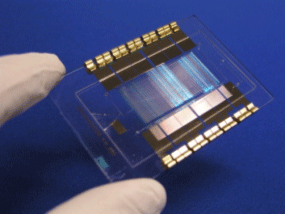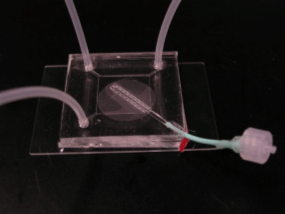 |
 |
|
|||||||||||||||||||||||||
|
| Micro Fluid Device for Bio and Environment | ||
Teruo Fujii, Prof., Production Technology Institute, Micromechatronics International Research Center We finished developing micro fluid device using semi-conductor technology, moving it forward to study of application of the device to environments or bio-field. The card-size device has micro space on its surface where chemical and biological reaction is analyzed. Such devices will be customized at any rate. I'm getting to provide basic technology on which its applied study can be practical with a wide scope. For that application, I can mention local measurement system at deep see investigation. There is a chip on the some square cm of the board. On the board, there's a graved ditch, 0.1mm in width, extending to 4m in length. The deep sea water is absorbed into the ditch where the water is chemically processed so that microbes' DNA can be taken. Then the taken DNA is processed for reproduction(PCR) using heat. Consequently the taken microbes or some objects are identified. Such research has been usually done on the ship with the deep sea water taken by diving vessels. They've got no deep sea sensor devices so far. If something like the fungi with methane oxidase in its DNA is identified, it could help methane hydrate called fire water be tracked down. It's in good use in cultivation of sells or tissue. It's normal to do it with plates as scharle, however, we use chips to providing the condition similar to the bio tissue where cells are cultivated. That method can be used in reproduction medical like growth of organs or tissues or outside artificial organ(bioreactor) for the weaken organs as liver. It's applied to cultivating cells for testing efficacy of medicine and toxin. We've succeeded to grow in vitro fertilized eggs of mouse in use of the microchips efficiently. To begin it, we cultivated uterine membrane on the multi-layered chip. The chip became the environment as same as uterine. Then we placed fertilized eggs on the chip, where the eggs became in shape to grow up in not more than 72 hours. With help of clinics dealing with sterility, we think we can utilize this method for this field. If we could verify the safety, we will help suffering women reduce their burden. Another application could be for breeding beef cattle. With this method, it is possible to measure how taken matters are absorbed in the small intestine. The toxin or medicine taken into doesn't go directly to organs but through intestines. For the two-layered chip, we take the upper as the wall of intestine, the lower as normal tissue. We pour chemical matter on the upper and see how it goes. The fact is that development competition of such devices began in Europe in '90s. The competition is fierce, but it's a home field to Japan. The devices is available not just on the earth but in space. It might be useful to probe extraterrestrial life. It's promising. |
||
I thought science and technology have something to move people as I watched Apollo's moon landing on TV. As I loved physics and chemistry, I went up to vessel engineering to study the under-sea. I was once engaged in development of self-auto prove robot for submerging. Then I challenged a new field and entered chemical and biological fields where I thought micro technology is fully applied and that such small thing could give rather big impact. In COE, bio-medical being a major, I'm responsible for developing such devices that can apply to medical treatment through tissue engineering(cyto engineering) and Protein/DNA analysis. I have many to do. I want to request the students love the story of his study and to tell us if it is practical or not. It's not necessary to go further. That's a job of companies. They should make the most of their time available and focus on things they want to do the most. I believe they have plenty of chances including study of overseas. |
||
|
||

<Personal Background> 1993:Doctor of Eng. of Ship marine eng. of postgraduate course of Tokyo Univ. Guest prof. of production and technological institute of Tokyo Univ. 95:Employed at Institute of Physics and chemistry. 99:assistant of research center of undersea of production and technological institute of Tokyo Univ. 2006:assistant prof. of Micromechatronics international institute center of production and technological institute of Tokyo Univ. 2007:prof . of the institute. |
| <<Back | Page top |

